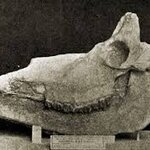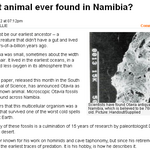Paleontology

Dinosaurs are starting to look less and less like they were portrayed decades ago. The fossil of Sciurumimus albersdoerferi, which lived around 150 million years ago, is the first evidence of feathered theropod dinosaurs that are not closely related to birds.
Theropods are bipedal, mostly carnivorous dinosaurs. In recent years, scientists have discovered that many extinct theropods had feathers but feathering had only been found in theropods that are classified as coelurosaurs, a diverse group including animals like T. rex and birds.
Sciurumimus is identified as a megalosaur, not a…
The iconic Coelacanth are fish well-known as ‘living fossils’. Coelacanths were thought to have died out with the dinosaurs and then a living one was caught off the coast of South Africa in 1938, sending waves of excitement throughout the scientific world.
A newly discovered extinct coelacanth is causing more waves because of a tuna-like forked tail, meaning it was probably a fast-moving, shark-like predator. This contrasts with living coelacanths, which are slow-moving fishes with peculiar broad tails bearing 3 lobes. The most complete fossils of this stunning 240 million-year-old…

Is it a shrub? No one really knows. A fossilized specimen, a roughly elliptical shape with multiple lobes, totaling almost seven feet in length, was unveiled today at the North-Central Section 46th Annual Meeting of the Geological Society of America, in Dayton, Ohio.
Around 450 million years ago, shallow seas covered the Cincinnati region and harbored one very large and now very mysterious organism. Despite its size, no one has ever found a fossil of this "monster" until its discovery by an citizen paleontologist, Ron Fine of Dayton, last year.
Fine is a member of the Dry…

Palaeontologists have found that not all Easter eggs come from the same “parent” species - some could be from dinosaurs, including a new species from the Pyrenees. An international group of researchers has helped to determine that dinosaurs have shaped the Easter eggs we buy.
Scientists were investigating whether 70 million-year-old fossil eggs found in the Pyrenees were laid by birds, or their dinosaur ancestors - researchers from the University of Leicester extended the study further by comparing Easter egg shapes to those of birds’ and dino eggs.
In their analysis, a mathematical…
A previously unknown species of giant, feathered tyrannosaur has been discovered in China, making it the largest-known feathered animal, living or extinct.
Tyrannosaurus rex and its cousins lived until around 65 million years ago and earlier relatives are thought to have been much smaller than the T-Rex we have come to know, but this notion has been challenged by the discovery of three specimens of a new species of tyrannosauroid from the Lower Cretaceous, 125 million years ago. The dinosaur, Yutyrannus huali, whose name translates from Latin and Mandarin as ‘beautiful feathered tyrant’,…
I couldn't possibly call myself a paleontology blogger and not post the fossil below as an article. Happily, I notice that it is friday today and so this can come under the banner of my oft forgotten feature of friday fossil.
It's pretty bloody difficult to reconstruct food webs for fossils, so we tend to rely on using clever methods like looking at microwear on teeth (a major research effort of my supervisor Mark Purnell) or other clever techniques like using isotope data. Sometimes we are lucky enough to find gut contents.
But sometimes you get fossils like this. This is literally a…

It's always the way.
Within the last week, there's been so many fantastic papers out that I literally have no idea where to start. People always seem to publish these things when I am most busy. It is most inconsiderate.
Anyway, together with a few other things I never got round to posting, I thought I might stick a little compendium up of some recent cool papers. I'm not planning on making this a regular feature - especially when you see how committed I am to my other "regular" feature (sorry about that, Helen!). So for this last week, here are my picks from the last week or so of…

This week's Friday fossil is Samotherium.
Samotherium is an ancient Giraffe. It's skull is two feet long, with two horns, and it's thigh bones are twice as big as a human's. These are its milk teeth, believe it or not,
Impressive, but that's not why I've featured it. The reason why it's featured is because it's possible that the famous skull of Samotherium may have provided the inspiration for the at least one version of the legend of the Griffin, according to Adrienne Mayor.
I won't say any more, but if you are intrigued enough, perhaps you should read her book. It's certainly good fun,…

I am pleased to present once again an interesting TED talk. O.K., the talk is a little on the slow side, but Jack Horner’s Shape Shifting Dinosaurs is worth watching, for it shows yet again something that cannot be repeated often enough: Scientists have a big huge ego and are therefore some of the easiest fooled people around.
Why are there so many different large dinosaurs while their babies are almost never found? Spoiler alert! Because apparently, not only do museums demand big dinosaurs, but scientists love to attach new names to stuff, because this then allows them to claim having…

Every 6 months or so these days it feels like we find the earliest animal life. More often than not, said life is something ugly that turns up in a bucket after dissolving rocks in acid.
Well, it's been a while, but here is the latest candidate:
I'll comment on the fossils in a bit, but before I get there, I have to say that, this paper is not just dubious. It's really, pretty bad. I was just going to let this be water under the bridge when I heard about it an hour or so ago. But then, I googled it, and saw that, predictably, most of the major news outlets had picked it up. So I thought I'd…